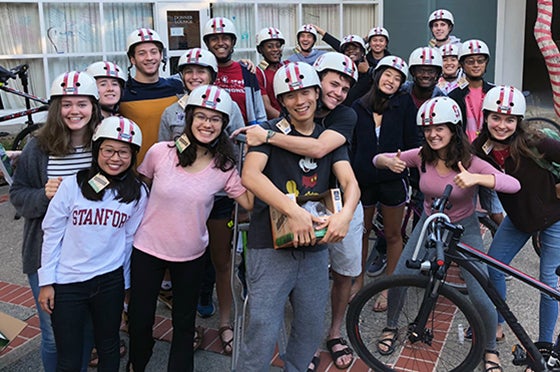Why parents/guardians and students should talk about bike safety

While biking is generally safe at Stanford, all it takes is one unfortunate crash to change a student’s life in an instant. Bike crashes happen. But wearing a helmet can change the outcome. Consider the tale of two students.
Without a helmet, she awakens in the hospital.
Stanford student Kali Lindsay was riding her bike to meet her tutor at the library. She never made it. Instead, Kali ended up in Stanford Hospital with her concerned parents at her bedside.
It isn’t clear how the accident happened. But, what is clear is that Kali wasn’t wearing a helmet when she fell from her bike in front of Larkin. She ended up unconscious, with a life-altering brain injury that impaired her ability to walk and to focus on books, television or a computer. She had to move home to recuperate. Kali was lucky. She eventually recovered and returned to Stanford.
With a helmet, she walks away.
Stanford undergraduate Anna Polishchuk had a different outcome. She was hit broadside by a car while biking on campus. Polishchuk hit the windshield of the car, which was going about 10 miles per hour through an intersection by Florence Moore (FloMo) Hall. She was thrown unconscious two car lengths away into the bushes.
“I was biking home from the dining hall, and then I find myself waking up on the ground,” Polishchuk said. Despite the severity of her crash, Polischuk escaped with minor injuries, which she attributes to wearing a helmet.
So what can parents and guardians do to help keep students safe?
To help parents or guardians have a conversation with their student about the importance of wearing a bike helmet, Ariadne Delon Scott, assistant director of active mobility at Stanford, offers three key messages:
1. Wear a bike helmet for every ride, even short trips. There are many excuses students cite for choosing not to wear a helmet: “It messes up my hair.” “I don’t want to carry it when I get there.” But how do these reasons hold up to the risk of brain injury—or worse—in a bike crash? If they won’t do it for themselves, perhaps they will do it for their parents or guardians. One student said he wears a helmet because he hated the thought of having his parents visit him in the hospital. He didn’t want to do that to them. Key message: Think of your helmet as a seat belt for your head. Seat belts save lives and so do bike helmets.
2. Follow the rules of the road. Did you know that bicyclists need to follow almost all of the same laws as motorists? This includes stopping at stop signs, using lights at night, and yielding to others who have the right of way at intersections and roundabouts. Would you drive a car in a crosswalk? We hope not! Neither should cyclists ride in crosswalks, but they often do, putting themselves at risk. Key messages: Get in the mindset of “driving” your bike. Stop at stop signs. Use a light at night. Walk bikes in crosswalks.
3. Don’t be a distracted rider. In our assessment of bike crashes on campus for the past three years, it appears the primary cause is distracted bike riding–hitting a fixed object, not seeing other riders, losing control of the bike. Too often, we see students riding while looking down and texting–with both hands!–and wearing earbuds, unaware of what’s ahead or around them. Key messages: Avoid cell phone use and multitasking on the bike. Give your undivided attention to the road and what’s all around you, including motorists, other bicyclists or skateboarders.
What is Stanford doing to help?
Bicycle safety is a priority at Stanford, and Stanford’s bicycle program collaborates with many others to promote bike safety. In addition to our own bike safety events and education efforts, we work with student teams, researchers, and concerned parents to encourage helmet use and bike safety at Stanford.

One example is the “I Love My Brain” symposium hosted by Stanford Synapse, a brain injury support group. This year, the event attracted more than 125 people, including students, educators, parents and researchers. It featured powerful and inspirational testimonies from survivors addressing the challenges of recovery and families serving as caregivers for those with a brain injury.
We’re here to help
Despite compelling testimonies, we realize that getting students to wear a bike helmet is an uphill battle, but it is a battle worth winning. Parent and guardian conversations could make a difference in keeping students safe. Contact us at bike-information@stanford.edu with any questions. We would be glad to help.
